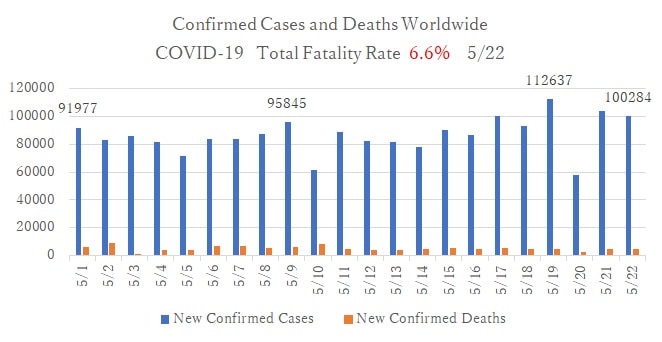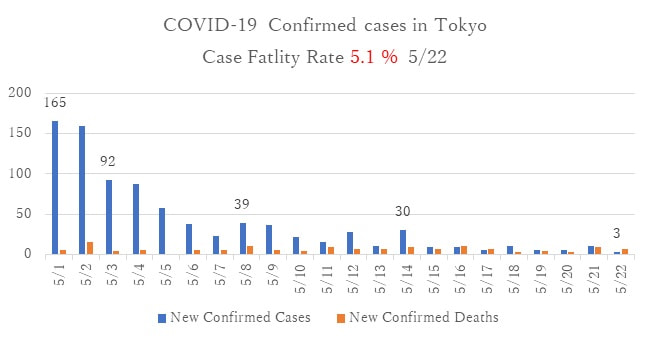SHARE
Services for the Health in Asian & African Regions (SHARE) = SHARE is a citizen sector organization (NGO) that engages in international cooperation mainly through providing health service.
HOME > News > Information of COVID-19(8)
- 【※updated】COVID-19(multi-language)
- Information of COVID-19(15)
- Information of COVID-19(vaccines)
- 《Request to the Government of Japan》Ease the protection of intellectual property rights and promote sharing and cooperating on pharmaceuticals and medical technologies, in order to accelerate efforts to overcome COVID-19 all over the world.
- Information of COVID-19(14)
- Information of COVID-19(13)
- Information of COVID-19(12)
- Information of COVID-19(11)
- SHARE Medical Information Line for Migrants is resumed in Oct.
- Information of COVID-19(10)
Information of COVID-19(8)

Information of COVID-19 (8)by SHARE 2020.05.26
1.Global and Japanese Situation of COVID-19
Confirmed cases of COVID-19 worldwide according to reports by WHO Update 2020/5/22 (Japan Standard Time) :
- Globally, the number of daily confirmed cases continues at more than 100,000.
- The daily confirmed cases also continue in: USA (more than 20,000); Brazil (from 10,000 to 15,000), and Russia (from 8,000 to 9,000). In Europe, the daily number of confirmed cases is decreasing.
Tokyo 2020/5/22(Japan Standard Time): MOHLW, Japan

- The number of daily confirmed cases is decreasing nationwide as well as in the Tokyo metropolitan area.
2.Why the number of death cases in Japan is smaller than other countries? The care for senior citizen at elder care homes.
- Care homes across Europe and the USA came into the spotlight over COVID-19 death rate, even though care homes are generally well prepared. Coronavirus clusters occurred in these residential care homes that did not provide added or supervised medical health care. Death rates in these residential care institutions have been significantly higher than in the general population. For instance, deaths in care homes account for almost half of all deaths in Sweden, one-third in France, and one-fifth in the United States.
- One of the factors that has facilitated the lower death rate among Japanese elderly is that elderly care has been provided in the hospital, and the number of residential care homes in Japan is relatively small. The nursing care bed rate per 1,000 population is 33.6 in Japan, 53.5 in France, and 71.5 in Sweden. Hospitals, here in Japan have 30% of these care beds, while in France it is less than 10%, and less than 5% in Sweden. Although Japan is a super-aging society, it can be said that hospitals are more responsible for elderly care. Additionally, older patients could stay at the hospital as long as they wished due to the low self-payment for eldercare.
- Another facilitating factor in Japan to be considered is that medical experts advised caregivers regarding infection control. The Ministry of Health, Labour and Welfare promotes the coordination between medical care and eldercare. For example, there are full-time medical doctors at long-term care facilities (Kaigo Rojin Hoken Shisetsu [1] ), visiting medical doctors at special elderly nursing home (Tokubetsu Yogo Rojin Home [2] ) and at other types of residential care homes.
- Sweden, has been critiqued because the government discouraged care home workers from sending residents into hospitals, as well as prevented care home and nursing staff from administering oxygen without a doctor's approval.
- Korea, where they are also experiencing a rapidly aging population, refers to the Japanese medical and elderly care insurance system and has increased nursing care beds by 36% in the last decade. 60% of these nursing care beds are in hospitals, which is the highest rate globally. The Korean government has successfully controlled the outbreak and has a smaller fatality rate related to COVID-19
[2] :Provides care for the elderly who wish to stay throughout their lives.
Reference:
・https://diamond.jp/articles/-/236988?page=2
・https://www.bbc.com/news/world-europe-52704836
・https://www.theguardian.com/world/2020/apr/09/care-homes-across-globe-in-spotlight-over-covid-19-death-rates
・https://www.nytimes.com/2020/04/17/us/coronavirus-nursing-homes.html
3.High COVID-19 attack rate following exposure at choir practice
- CDC reported that superspreading events caused COVID-19 at Skagit county, Washington, on March 17th.
- According to CDC, "Following a 2.5-hour choir practice attended by 61 persons, including a symptomatic index patient, 32 confirmed and 20 probable secondary COVID-19 cases occurred; three patients were hospitalized, and two died. Transmission was likely facilitated by close proximity (within 6 feet) during practice and augmented by the act of singing. The potential for superspreader events underscores the importance of physical distancing, including maintaining at least 6 feet between persons, avoiding group gatherings and crowded places, and wearing cloth face coverings in public settings where other social distancing measures are difficult to maintain during this pandemic."
- Adding to the above events, the pandemic on cruise ships and clusters at live houses explains the importance of avoiding the 3Cs (closed spaces, crowded places, and close-contact settings).
- Information of COVID-19(1)(ENGLISH)
- Information of COVID-19(2)(ENGLISH)
- Information of COVID-19(3)(ENGLISH)
- Information of COVID-19(4)(ENGLISH)
- Information of COVID-19(5)(ENGLISH)
- Information of COVID-19(6)(ENGLISH)
- Information of COVID-19(7)(ENGLISH)
- Information of COVID-19(8)(ENGLISH)
- Information of COVID-19(9)(ENGLISH)
Reference:
・High SARS-CoV-2 Attack Rate Following Exposure at a Choir Practice -- Skagit County, Washington, March 2020
・Weekly / May 15, 2020 / 69(19);606-610
・https://www.cdc.gov/mmwr/volumes/69/wr/mm6919e6.htm?s_cid=mm6919e6_e&deliveryName=USCDC_921-DM28272
Written by Nakasa T, MD, Co-President of SHARE
Koto K, RN, SHARE advisor
Koto K, RN, SHARE advisor
■English Information
■Useful URLs by multi-languages




